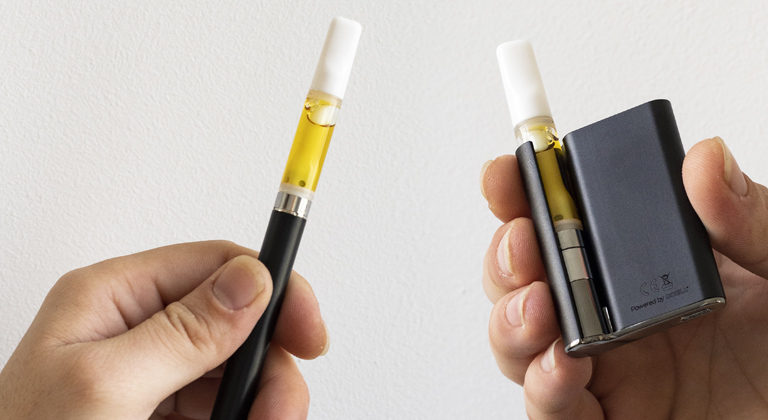Science is exploring the protective properties of caryophyllene for the treatment and prevention of degenerative eye diseases such as glaucoma and age-related macular degeneration.
This terpene is showing potential benefits for the health of our eyes, and is found in foods like black pepper or clove as well as in cannabis (it’s one of its main terpenes).
Let’s analyze how caryophyllene could be included in future treatments for vision-related diseases and explore the scientific studies supporting its use.
Caryophyllene and its Interaction with the Endocannabinoid System: A Very Special Terpene
Before delving into the therapeutic potential of caryophyllene for eye diseases, it’s necessary to explain one of its most unique virtues. Unlike other terpenes in the aromatic profile of cannabis, caryophyllene has the ability to interact with the endocannabinoid system.
This is a system of receptors (CB1 and CB2), spread across various organs in our body, which ensure vital functions are in balance. Its role includes the regulation of processes like pain, inflammation, the immune system, and even aspects of mood.
What makes caryophyllene so special is that, just like cannabinoids, it can activate the receptors of the endocannabinoid system (specifically CB2). Thus, caryophyllene becomes a selective CB2 agonist, a receptor primarily found in immune system cells and involved in the reduction of inflammation and the protection of cells.
The Importance of Endocannabinoid System Receptors in the Eyes
Various scientific studies have uncovered the presence of CB1 and CB2 receptors of the endocannabinoid system in the eyes. Apparently, these receptors play a key role in protecting the eyes from external damage, such as ultraviolet rays, which can trigger inflammatory responses.
These receptors appear to be present in the retina; and, although each has a different function, both play a crucial role.
CB2 receptors (those that caryophyllene interacts with) are involved in the regulation of inflammation in ocular tissues. When these receptors are activated, they can reduce chronic inflammation and protect both optic nerve cells and retinal cells from potential damage. This is vital in conditions like glaucoma and macular degeneration, where inflammation and cell damage can lead to vision loss. (1)
Moreover, recent research suggests that CB2 receptors may also influence the retina’s response to light exposure and overall cell health. This indicates that activating these endocannabinoid system receptors in the eyes can protect them from inflammatory damage and serve as an organ protector from external stimuli, promoting healthier vision.
Since caryophyllene is a CB2 receptor agonist (capable of activating these receptors), this terpene has potential therapeutic properties that could be incredibly useful in treating and preventing diseases related to the aforementioned processes.
The Therapeutic Potential of Caryophyllene for the Eyes
Several scientific studies suggest that caryophyllene, for all the reasons mentioned above, may have the following therapeutic properties for the eyes:
- Anti-inflammatory: Both glaucoma and macular degeneration are conditions closely related to chronic inflammation of eye tissues. As the inflammatory process progresses, it causes structural damage to the optic nerve and retinal cells, leading to gradual vision loss. Several studies suggest that caryophyllene could reduce the production of inflammatory cytokines and protect ocular tissues from further damage, which could be vital in preventing or treating these diseases.
- Protection Against Oxidative Damage: Oxidative stress is one of the causes of many eye diseases. It occurs when reactive oxygen species (ROS) accumulate in the cells, which over time causes deterioration of the cells, including those of the ocular tissue. Studies have demonstrated the ability of caryophyllene to neutralize ROS production, protecting retinal and optic nerve cells. (2)
- This terpene also affects other important receptors like PPAR-γ, which are involved in the regulation of metabolism and inflammation. This unique ability to activate multiple pathways makes caryophyllene a compound with tremendous potential for various medical applications, including eye diseases.
While more research is still needed to determine how caryophyllene could be applied in future eye disease treatments, recent scientific findings are promising. Patients with diseases like glaucoma, macular degeneration, or diabetic retinopathy could benefit from this to prevent blindness.

How to Include Caryophyllene in Your Daily Life
Caryophyllene is a terpene naturally found in many plants and fruits in the plant kingdom. Some fruits and plants rich in this compound include:
- Clove: A natural source with a high caryophyllene concentration; widely used in traditional medicine and cooking.
- Hops: Used in beer production, hops also have significant caryophyllene levels, contributing to the aroma and flavor of this drink.
- Cinnamon: This common culinary ingredient also contains caryophyllene.
- Rosemary: An aromatic plant frequently used in Mediterranean cuisine which is also a good source of this terpene.
- Basil: Caryophyllene in basil contributes to its medicinal properties and distinct aroma.
- Oregano: A natural source of caryophyllene, especially in spicier oregano strains.
- Cannabis: Caryophyllene is one of the primary terpenes in cannabis, and is present in high levels in some strains, influencing their effects and aromas.
Cannabis Strains with High Caryophyllene Content
Although caryophyllene is found to a greater or lesser extent in all cannabis strains, some have a significantly higher content:
- Gorilla Glue: This wild beast of the cannabis world has a really high caryophyllene ratio, which contributes to its effects and aromas.
- OG Kush: This legendary West Coast strain also has high caryophyllene levels, contributing to the unmistakable taste that so many users love.
- Gelato: A widely acclaimed strain at global level which is also a good carrier of high proportions of this versatile terpene.
Using terpene profiles with high caryophyllene levels in products like tinctures, vaporizer cartridges, and e-liquids, or adding them to food or drinks, is also a great way to introduce this powerful terpene into our bodies.
It’s crucial to remember that terpenes or terpene profiles should NEVER be applied directly to the eyes, as they are in pure form and could cause severe harm to the ocular area instead of achieving the desired therapeutic effect.
Terpene profiles should always be consumed at the right doses for each format, whether orally or vaporized, for an optimal and safe sensory and therapeutic experience.

Conclusion
Science continues to advance in studying the properties of terpenes like caryophyllene, which due to its ability to interact with CB2 receptors, can reduce inflammation and protect against oxidative damage to our vision.
This makes it a promising candidate for preventing and treating degenerative eye diseases such as glaucoma and macular degeneration. We hope to see future treatments including this terpene that will be more natural and effective.
Meanwhile, the Cali Terpenes team will continue sharing the latest scientific advancements on this topic. Follow us on social media for more interesting content and subscribe to our newsletter!









